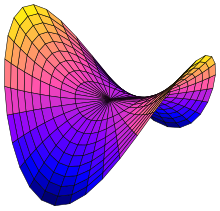This article needs additional citations for verification. (June 2020) |

In geometry, a paraboloid is a quadric surface that has exactly one axis of symmetry and no center of symmetry. The term "paraboloid" is derived from parabola, which refers to a conic section that has a similar property of symmetry.
Every plane section of a paraboloid by a plane parallel to the axis of symmetry is a parabola. The paraboloid is hyperbolic if every other plane section is either a hyperbola, or two crossing lines (in the case of a section by a tangent plane). The paraboloid is elliptic if every other nonempty plane section is either an ellipse, or a single point (in the case of a section by a tangent plane). A paraboloid is either elliptic or hyperbolic.
Equivalently, a paraboloid may be defined as a quadric surface that is not a cylinder, and has an implicit equation whose part of degree two may be factored over the complex numbers into two different linear factors. The paraboloid is hyperbolic if the factors are real; elliptic if the factors are complex conjugate.
An elliptic paraboloid is shaped like an oval cup and has a maximum or minimum point when its axis is vertical. In a suitable coordinate system with three axes x, y, and z, it can be represented by the equation[1] where a and b are constants that dictate the level of curvature in the xz and yz planes respectively. In this position, the elliptic paraboloid opens upward.

A hyperbolic paraboloid (not to be confused with a hyperboloid) is a doubly ruled surface shaped like a saddle. In a suitable coordinate system, a hyperbolic paraboloid can be represented by the equation[2][3] In this position, the hyperbolic paraboloid opens downward along the x-axis and upward along the y-axis (that is, the parabola in the plane x = 0 opens upward and the parabola in the plane y = 0 opens downward).
Any paraboloid (elliptic or hyperbolic) is a translation surface, as it can be generated by a moving parabola directed by a second parabola.
- ^ Thomas, George B.; Maurice D. Weir; Joel Hass; Frank R. Giordiano (2005). Thomas' Calculus 11th ed. Pearson Education, Inc. p. 892. ISBN 0-321-18558-7.
- ^ Weisstein, Eric W. "Hyperbolic Paraboloid." From MathWorld--A Wolfram Web Resource. http://mathworld.wolfram.com/HyperbolicParaboloid.html
- ^ Thomas, George B.; Maurice D. Weir; Joel Hass; Frank R. Giordiano (2005). Thomas' Calculus 11th ed. Pearson Education, Inc. p. 896. ISBN 0-321-18558-7.

